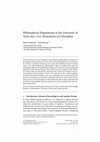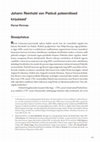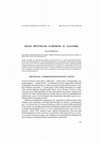Papers by Pärtel Piirimäe
Comparative Legal History, 2024
Review of: Early modern natural law in East-Central Europe, edited Gábor Gángó (Early Modern Natu... more Review of: Early modern natural law in East-Central Europe, edited Gábor Gángó (Early Modern Natural Law; 5). Brill, 2023, 403 pp, €127.20 (hbk), ISBN 9789004545823.

Acta Historica Tallinensia, 2024
The article discusses various uses of the concept of “freedom” in the
debate on serfdom, which wa... more The article discusses various uses of the concept of “freedom” in the
debate on serfdom, which was sparked by the 1766 essay competition
held by the Free Economic Society of Saint Petersburg. An analysis of
the competition entries helps place Enlightenment ideas in the Baltic
region within the broader context of Russian imperial and European
Enlightenment, as entries were submitted by authors from across Europe,
including several works by writers from Livonia. The article focuses on
the concept of freedom as understood by Johann Georg Eisen, pastor
of Torma and one of the earliest critics of serfdom, whose radical views
stand out starkly when compared with the freedom concepts in the
competition’s winning essays by Beardé del’Abbaye, J. J. L. Graslin,
J. C. Wöllner, E.J. von Meck, and A.J. Polenov. Eisen was not the only
author who spoke of freedom and property as natural or human rights.
However, while other authors considered the loss of freedom for certain
social groups (i.e., serf peasants) inevitable, and the restoration of that
freedom, at least in the near future, impossible, Eisen believed that
improving society and achieving general welfare was impossible without
freedom for all individuals.
The article argues that Eisen’s understanding of freedom as
inalienable human right is based on a fundamentally different moral
anthropology from that of other authors, leading to opposing views on the possibility of establishing universal personal freedom within
their contemporary society. At the core of the debate is the question of
whether freedom is a prerequisite for a person’s moral, intellectual, and
economic self-improvement, or whether freedom is only beneficial after
achieving a certain level of moral maturity. Thus, already in the 1760s,
a long-standing debate was ignited within the Baltic Enlightenment
between a more moderate and a more radical approach — on whether
peasants should first be educated to prepare them for freedom without
threatening social order, or rather be freed first so that they could be
educated in the first place.
Like other authors, Eisen set limits on freedom. Freedom as a
human right did not entail the right to arbitrarily pursue any individual
goals, as the primary aim was the attainment of social harmony, in which
each estate fulfils its distinct and exclusive role. However, social welfare,
in his view, was not possible unless every individual could strive for
personal happiness within the economic framework appropriate to their
estate. In Eisen’s worldview, therefore, general welfare was not based on
the care of rulers and lords for their subordinates, as the paternalistic
worldview suggested, but rather on contractual relationships driven
by the legitimate self-interest of all parties involved. At the same time,
Eisen’s “grand plan” can also be described as a social utopia, in which
the functions of all estates are precisely delineated so that they do not
compete over limited resources but instead make a complementary and
harmonious contribution to society.
Muutused, ümberkorraldused, uuendused. Varauusaja arengujooned Eesti- ja Liivimaal 1520-1800, 2023
What is the Early Modern Period? On the Periodization in European and Estonian History
Berghahn Books, Dec 31, 2022

Studia Philosophica Estonica, 2016
The article focuses on the definitions and divisions of philosophical disciplines in the disputat... more The article focuses on the definitions and divisions of philosophical disciplines in the disputations presented at the University of Tartu during the first two periods of its existence: Academia Gustaviana (1632--1656) and Academia Gustavo-Carolina (1690--1710). The classifications of philosophy in Tartu are studied in the context of competing traditions of classifying knowledge and the spread of novel pedagogical methods in early modern Europe. These trends were also reflected in the university statutes that were directly borrowed from the University of Uppsala, the parent institution of the academy in Tartu. The article shows that a strong emphasis on Ramist methods of teaching in the 1632 constitution and a similar prominence given to Aristotelianism in the 1689 constitution affected, to some extent, the priorities given to certain disciplines in the faculties but did not always determine the division of responsibilities between professors nor the conceptual tools and contents of...

Forschungen zur baltischen Geschichte, 2013
Th is article is a contribution to the historiographical debates about the
character of the polit... more Th is article is a contribution to the historiographical debates about the
character of the political system of late medieval Livonia. It focuses on the
institution of the Diet (Landtag) during the reign of Wolter von Plettenberg,
the infl uential Master of the Livonian branch of the Teutonic Order. Th e
Diet was the only institution that gave political unity to the conglomerate
of princely territories of Livonia (the Order, the Archbishopric of Riga and
the Bishoprics of Tartu, Saaremaa and Curonia). Th e broad question posed
in the article is whether the Diet should be viewed principally as an assembly
of estates (clergy, nobility, towns) or as a gathering of territories. Th is,
in turn, would enable us to decide whether or not Livonia was developing
the characteristics of a unitary state or remained a loosely bound confederation
until its end in the Livonian War.
Th e analysis of the functions, structure and procedures of the Diet show
that it was an irregular institution with restricted responsibilities and
authority. Its main function was to organize Livonian common foreign
and defence policy and to solve internal political confl icts. In these issues
the Diet was acknowledged as the highest authority and the decisions were
usually successfully carried out. In internal matters where common legislation
was seen as desirable, such as monetary reform, export restrictions,
delivery of escaped peasants or foundation of educational establishments,
the authority of the Diet was not universally recognized. Th erefore, the
Diet seldom reached binding resolutions when dealing with these issues,
and those reached were rarely carried out in practice. A major reason for
the ineffi ciency of the Diet was the lack of an executive organ operating on
the level of Livonia as a whole. Th e execution of resolutions fell to princes
in their separate territories, which increased the power of the territories at
the expense of the Diet.
Th e Diet was summoned and directed according to 15th -century custom,
which gave equal importance to the Livonian Master and the Archbishop
of Riga. Yet, it seems that Plettenberg managed to dominate most Diets of
the period. Th is was partly due to the division of labour between the Master
and the Archbishop: the Master was responsible for the coordination
of the foreign policy and defence of the land; the Archbishop for internal
matters, church and education. Th e main functions of the Diet during the
period under observation coincided with the responsibilities of the Master,
while the matters brought forward by the Archbishop remained secondary.
Th e study of the structure and procedures of the Diet do not give an
unequivocal answer to the question whether it was primarily an assembly
for the negotiation between the embassies of the territories or a typical
early modern proto-parliamentary assembly where the corporations
negotiated with their lords about reciprocal rights and duties. Th e form of
the negotiations was largely similar to the Landtage in German princely
territories and the Reichstage in the Empire, where the plenary sessions
alternated with negotiations within corporations. However, the Livonian
Diet was diff erent in several important respects. Firstly, the structure of
the Diet was a unique combination of corporate and territorial principles:
while the nobility and burghers of all territories of Livonia formed two
curiae along the usual lines of social estates, the higher clergy – bishops
with their chapters and the Order – formed two separate curiae. Secondly,
the combination of corporate and territorial principles was also refl ected
in the form of negotiations: a large part of the negotiations were held not
in curiae or in plenary sessions but within territorial embassies. Th us, the
Diet was both a forum where lords and their estates negotiated their differences,
and a meeting place for the leadership of the Livonian territories.
Th e negotiations tended to take place in curiae when the subject matter
concerned the rights and duties of the estates towards their lords. However,
such matters were usually not regarded as belonging to the sphere of
authority of the Diet but were to be solved on the territorial level. When,
on the other hand, specifi c political issues or confl icts between territorial
lords were discussed, the negotiations happened largely within territorial
embassies and the common viewpoint of the territory was then presented
to the plenary meeting.
Th e most autonomous among the corporations were the large Hanseatic
towns of Livonia (Riga, Tartu and Tallinn), whose specifi c trade-related
interests often diverged from those of their lords. Th e noble corporations
and chapters, on the other hand, did not form a distinct interest group on
the Livonian level, since their only concern was the preservation of their
privileges within territories. Th e events of the 1520s demonstrated that as
long as these were guaranteed, the nobility had no incentive to cooperate
with their fellows in other parts of Livonia. Th erefore no institutionalized
union of all Livonian noble corporations emerged.
Th e analysis of the procedures of the Diet revealed a number of factors
that inhibited its decision-making capacity. Th e most signifi cant of those
was the restricted mandate of the representatives of the corporations and
the lords who did not appear in person. Th e other problem was the demand
for consensus in the plenary session. Th e lords were well aware why the
Diets often proved fruitless and made an eff ort to improve their procedures.
One method was to send the propositions to other lords and corporations
prior to the Diet so that they could give a more precise mandate to their
envoys. Secondly, the convenors of the Diet insisted on giving a broader
mandate to the representatives, which, as it appeared, was not consistent
with sixteenth-century notions of legality.
Th e article concludes that in the era of Wolter von Plettenberg, the Livonian
Diet was fi rst and foremost a forum for negotiations between the
embassies of Livonian territories led by their lords. Th e only estate that
exercised autonomous policy were the burghers of the Hanseatic towns.
Th e participation of other political estates (noble corporations and chapters)
in the Diet was an expression of the signifi cant role they had acquired
in the government of their territories. Th e rise of the role of nobilities on
the territorial level increased their corporate consciousness on the Livonian
level as well but it was not suffi cient to generate new institutions in
addition to the Diet. Th e preoccupation of the Diet with specifi c issues
of foreign policy, defence and internal confl icts, and the lack of authority
over internal legislation demonstrates the weakness of Livonian regional
integration. Th e common identity of the Livonian estates lacked the muscle
to transform Livonia into a single, unifi ed state. Th is proved fatal in
the 1550s when the Livonian territories failed to rally to each other’s aid to
face the growing threat from Russia and fell victim to the Livonian War

Ajalooline Ajakiri. The Estonian Historical Journal, 2022
Kui ma 2006. aastal pärast Cambridge'i ülikoolis doktoritöö kaitsmist Tartu ülikoolis tööle asusi... more Kui ma 2006. aastal pärast Cambridge'i ülikoolis doktoritöö kaitsmist Tartu ülikoolis tööle asusin, oli Ajalooline Ajakiri sisuliselt varjusurmas. Viimane number oli ilmunud 2003. aastal kaanenumbriga 2002, nr 3 (118). Eesti teadusajakirjade maastikuga kursisolevad inimesed teavad, et meie kitsukeses teadusruumis nõuab ajakirja täitmine kvaliteetse sisuga pidevat aktiivset suhtlust potentsiaalsete autoritega, mis tähendab, et peatoimetaja töö maht on suurem, kui see väljastpoolt paistab. Kahjuks ei olnud professor Aadu Mustal, kes oli olnud ajakirja taaskäivitaja ja peatoimetaja alates 1989. aastast, viimastel aastatel muude oluliste ühiskondlike ametikohtade (Tartu linnavolikogu esimees 2001-7, riigikogu liige) kõrval enam ajakirja jaoks piisavalt aega, mistõttu kaastööde portfell oli jäänud kiratsema ja numbrid järjest rohkem hilinema. Nii tegigi ta mulle 2006. aastal ettepaneku ajakirja toimetamine üle võtta. Aadu eestvõttel taotlesin Euroopa Liidu meetme 1.1. raames rahastust kaheaastasele teadus-arendusprojektile, mille üheks eesmärgiks oli ajakirja uuesti käimalükkamine. Peatoimetamise töö moodustas vastavalt projektile 50% minu töökoormusest. Taotlus osutus edukaks, mis võimaldas paar aastat üsna intensiivselt ajakirjaga tegeleda. Pärast seda jätkasin peatoimetaja ametiga muude töökohustuste kõrvalt. Toimetuse töö järjepidevuse tagas Anu Lepp, kes oli ajakirja juures olnud alates 1999. aasta viimasest numbrist ning ilma kelleta poleks taaskäivitamine võimalik olnud. Anu vastutas asjaajamise ja finantsidega seotud bürokraatliku poole eest, aga võttis enda peale ka keelelise toimetamise ja pildimaterjali otsimise. Diplomeeritud ajaloolasena oli ta abiks ka sisu puudutavates küsimustes. Minu kui peatoimetaja hooleks jäi artiklite komplekteerimine, suhtlemine autorite ja retsensentidega ning tekstide sisuline toimetamine. Ajakirja juures jätkas ka senine toimetuskolleegium. Et osa neist oli juba emeriteerunud, kutsusime lisaks mõned nooremad kolleegid nii Tartust kui mujalt maailmast. Esimestel nõupidamistel jõudsime arusaamisele, et pole mõtet jätkata täpselt sealt, kust ajakiri pooleli jäi. Uuesti graafikusse jõudmine polnud realistlik ning otsustasime võlgu olevad numbrid vahele jätta ja alustada 2007. aastal n-ö puhtalt lehelt. Seega tuli leppida asjaoluga, et lisaks

Eesti Ajalooarhiivi toimetised, 2009
This article is a case study of early modern political polemics that focuses on the figure
of Jo... more This article is a case study of early modern political polemics that focuses on the figure
of Johann Reinhold von Patkul (1660–1707), the leader of the Livonian nobility in their
opposition to the land-recovery project of King Charles XI of Sweden. In 1694 Patkul was sentenced to death for his seditious writings, but managed to flee Sweden and served later as councillor, diplomat, and army general in the courts of August II of Poland-Saxony and Peter the Great of Russia, notably helping to form and uphold the alliance that fought Sweden in the Great Northern War. Patkul’s fame was enhanced posthumously by his remarkable fall: while serving as the Russian ambassador at Dresden court, he was imprisoned by the Saxons and delivered to the Swedes, who were finally able to carry out the death sentence.
This article is the first attempt at a systematic survey of polemical debates around
Patkul during his lifetime. This is a less-known aspect of Patkul’s life, but by no means
an unimportant one. It was typical of Patkul’s activities that they were almost constantly accompanied by flurries of polemical battles, in which he himself played a major role. Patkul understood the value of skilful propaganda for making and breaking reputations and hence for achieving one’s political aims. Patkul was no scholar but he was sufficiently educated (having studied at the University of Kiel) and witty to put his pen into effective use for the Livonian nobility, for his royal masters, and, finally, for himself.
The article is divided into three major parts. First, it studies the writings (which
were deemed seditious by the royal court) that Patkul presented in the name of the nobility in the early 1690s. In these writings, Patkul outlined his views on the constitutional relationship of Sweden and Livonia, presenting it as a personal union in which both parts preserved their inherited rights and privileges, so that any royal initiative could only be implemented in Livonia with the express consent of the local estates. Patkul’s language of «rights» offended the sensibilities of the royalists who envisioned the king as an absolute and benevolent ruler who held responsibility for the common good of the entire realm, including Livonia. In their view, the nobility’s privileges did not have any other foundation than the royal will, and the king could revoke them if he deemed it necessary for the security and welfare of the realm.
The second major part of the article deals with the period of Patkul’s employment
at the courts of August II and Peter I during the early stages of the Great Northern War,
focusing, in particular, on his role as the author of writings that justified to international
audiences the aggression of Saxony and Russia against Sweden. Patkul compiled documents in the name of the Livonian nobility that enabled August II to present his invasion as a campaign to liberate Livonia from «Swedish slavery», and he was also the probable author of the official manifesto in which this argument was put forward. While still in the service of Saxony, Patkul also offered his helping hand to the Russians, who had trouble justifying their aggression against Sweden to European audiences. Patkul drafted an alternative explanation for Russian actions that was spread unofficially as «Baron Langen’s relation». As opposed to official Russian declarations which, in a rather old-fashioned manner, explained the aggression as a response to offences suffered by the Tsar’s embassy in Riga in 1697, Patkul offered a totally different set of reasons that were more in line with contemporary international law.
The third part looks at the writings that Patkul published in 1701 and 1702. They
were aimed at European readers to refute Swedish polemical attacks against his personal reputation and prove his innocence and the injustice of the Stockholm trial. In these writings, Patkul also used the opportunity to put forward, in a more systematic manner, his views on the status of Livonia in the Swedish empire and on the rights and duties of kings and subjects in general. His argument drew heavily on the modern doctrine of natural law, particularly the ideas of Samuel Pufendorf, which he skilfully applied to justify the traditional Livonian political system based on medieval common law principles of reciprocal rights and duties. The article ends with a short survey of polemics around Patkul at the final stages of his life. A comprehensive bibliography of both published and unpublished writings by Patkul and his opponents is included.

Acta Historica Tallinensia, 2020
(See below for the abstract in Estonian)
The article aims to survey the research on intellectu... more (See below for the abstract in Estonian)
The article aims to survey the research on intellectual history in Estonia during the first two decades of the 21st century. In order to appreciate the current institutional status of the discipline and its state of research, the first part of the article gives a short overview of the earlier history of the research field in Estonia against the background of the developments elsewhere in the world. The history of ideas or intellectual history emancipated as a distinct field of study in Sweden and the United States in the 1930s, and gained broad acceptance at universities in Western countries after World War II. Although in Estonia scholarly interest in the ideas of the past can be traced back to the early 20th century, the development of the discipline was hindered by the long period of the Soviet occupation, when materialist Marxist-Leninist doctrine as the only acceptable interpretation of history was enforced. Nevertheless, despite ideological pressure and censorship, progress was made in various aspects of the earlier intellectual history in Estonia, such as the history of education and science, or the ideas of the ‘national awakeners’ in the 19th century.
Since the regaining of independence in the 1990s, intellectual history as an academic research field has gained an increasingly important status in Estonian academia, which can be explained by four factors. Firstly, historians who started their careers in the Soviet period were able to publish the results of their lifelong research without censorship. Secondly, a new generation of historians has emerged who have received their degrees in various European centres of the study of intellectual history, and have upon their return initiated similar research and teaching at Estonian universities. Thirdly, there has been a notable shift in neighbouring disciplines of the humanities towards questions and approaches characteristic of intellectual history, among them literary studies, classical studies, religious studies, history of science, art history, history of law, etc. Intellectual history has often functioned as the meeting point for these fields in a situation in which interdisciplinary cooperation has been enhanced both by the smallness of Estonian academia and the preference of funding bodies for large scale projects. Fourthly, the key texts by historical authors have been made easily available to the general public, which has increased general interest and facilitated teaching and research in intellectual history. Most important among these is the History of Estonian Thought (Eesti mõttelugu) book series published by Ilmamaa, although one should also note the digital databases developed by Tartu University Library and the National Library of Estonia. As a result of these factors, in the early 21st century several academic positions in the field of intellectual history, the history of political thought and political philosophy have been created at the Universities of Tartu and Tallinn.
The article outlines the main methods and genres that have been employed in research in intellectual history over the past two decades. One can notice a rich variety of approaches, which are not easily reduced to a clear catalogue, particularly since the scholars have not always been explicit about their methods or have used a mixture of methods. However, it seems possible to distinguish between the scholarship which, influenced by the contextualist method advanced by the Cambridge school, attempts to reconstruct the intentions of the historical authors in the particular pragmatic and ideological contexts of their era, and scholarship that studies the ‘spirit of the age’ or the emanation of some transcendent ideas across swathes of time, perhaps influenced by the German tradition of Geistesgeschichte or the Lovejoyan school of the history of ideas. With regard to genres, the (intellectual) biography has been the preferred choice, although there are also examples of collective biographies and thematically oriented books.
The article concludes with a discussion of possible methodological pitfalls associated with certain methods and genres, and with a sketch of potential avenues for future research.
Artikli eesmärgiks on anda ülevaade mõtteloo uurimisest Eestis 21. sajandi esimestel kümnenditel. Et paremini mõista mõtteajaloo või intellektuaalajaloo hetkeseisu, heidetakse artiklis pilk selle eelloole Eestis avant la lettre ehk enne valdkonna distsiplinaarset emantsipeerumist ning vaadeldakse lühidalt valdkonna tähtsamaid arengusuundi mujal maailmas 20. sajandil ja 21. sajandi algul. Sellel taustal eritletakse peamisi meetodeid ja žanre, mida on viimastel aastakümnetel kasutatud mõtteloo uurimisel Eestis, arutletakse eri käsitlusviiside eeliste ja puuduste üle ning võetakse kõne alla võimalikud eda sised uurimisperspektiivid.
Cambridge University Press eBooks, Nov 17, 2022
Ajalooline Ajakiri the Estonian Historical Journal, 2008
Ajalooline Ajakiri. The Estonian Historical Journal
Ajalooline Ajakiri. The Estonian Historical Journal, Dec 21, 2015

European Regions and Boundaries, 2017
The Emergence of "the Baltic" as a Region The toponym "Baltia" fi rst appears in Greco-Roman geog... more The Emergence of "the Baltic" as a Region The toponym "Baltia" fi rst appears in Greco-Roman geographical writings. Pliny the Elder writes in his Natural History that "Xenophon of Lampsacus tells us that at a distance of three days' sail from the shores of Scythia, there is an island of immense size called Balcia, which by Pytheas is called Basilia" (Plinius Secundus [77-79 A.D.] 1906, IV.95, 23-79). The alternative names mentioned by the geographers of antiquity are "Abalus" (used by Pytheas according to Pliny) and "Basileia" (by Diodorus in Historical Library) (Plinius Secundus [77-79 A.D.] 1906, XXXVII.11; Diodorus Siculus [60-30 B.C.] 1939, V.23). Common to all these references is that the authors mention great quantities of amber that are washed up on the shores of this "island," and therefore it is most likely that Balcia/Baltia was the eastern coast of the Baltic Sea. The etymological origins of the word are not clear, as the root balt can in Baltic and Slavic languages refer to "white" (Latvian balts, Lithuanian baltas) or "lake, marshland" (Russian boloto), but it has also been associated with Germanic belt that originates from Latin balteus (Jansen 2005, 35). The eleventh-century chronicler Adam of Bremen was apparently the fi rst to call the sea Mare Balticum, and this usage was well established by the fi fteenth to sixteenth centuries (Berkholz 1882; Jansen 2005, I, 35). The variations of Balticum became adopted as the name of this sea in English, Romance languages, Slavic languages, and also Baltic languages (Latvian and Lithuanian). A number of European nations, however, use a name that refers to the relative geographical location of the sea. For Germans (Ostsee, but historically also Baltisches Meer), Dutch (Oostzee), Swedes (Östersjön), Danes (Østersøen), Norwegians (Østersjøen), and Icelanders (Eystrasalt), it is naturally "the Eastern Sea," but curiously also the Finns, who live on its eastern coast, have This chapter is from European Regions and Boundaries edited by Diana Mishkova and Balázs Trencsényi.
1710 - Die Kapitulationen der baltischen Ritterschaft im Nordischen Krieg, 2013
The Roman Foundations of the Law of Nations, 2010
The Past, Present and Future of a Contested Concept, 2010

The Law of Nations and Natural Law 1625-1800, 2019
The chapter aims to offer a new perspective on Emer de Vattel’s natural jurisprudence by placing ... more The chapter aims to offer a new perspective on Emer de Vattel’s natural jurisprudence by placing it into the context of Enlightenment philosophical histories. It argues that Vattel’s normative system was anchored in an account of history that was informed not only by the diplomatic histories of Europe but also by a specific vision of progress that drew heavily on Voltaire’s historical writings. It was a vision of the advancement of humanity driven by enlightened monarchs who had a correct understanding of enlightened self-interest and true glory. Both for Voltaire and for Vattel, the self-civilizing drive was best exemplified by Tsar Peter the Great. To explain Peter the Great’s role in Vattel’s theory, the chapter turns to the distinction between men and monsters, which functioned in his theory as a tool for affirming the validity and enforceability of natural justice. The figure of Peter served to underline this distinction and to point to the essence of a minimum morality that was the basis for more advanced, polished and humane forms of morality in the course of human progress.











Uploads
Papers by Pärtel Piirimäe
debate on serfdom, which was sparked by the 1766 essay competition
held by the Free Economic Society of Saint Petersburg. An analysis of
the competition entries helps place Enlightenment ideas in the Baltic
region within the broader context of Russian imperial and European
Enlightenment, as entries were submitted by authors from across Europe,
including several works by writers from Livonia. The article focuses on
the concept of freedom as understood by Johann Georg Eisen, pastor
of Torma and one of the earliest critics of serfdom, whose radical views
stand out starkly when compared with the freedom concepts in the
competition’s winning essays by Beardé del’Abbaye, J. J. L. Graslin,
J. C. Wöllner, E.J. von Meck, and A.J. Polenov. Eisen was not the only
author who spoke of freedom and property as natural or human rights.
However, while other authors considered the loss of freedom for certain
social groups (i.e., serf peasants) inevitable, and the restoration of that
freedom, at least in the near future, impossible, Eisen believed that
improving society and achieving general welfare was impossible without
freedom for all individuals.
The article argues that Eisen’s understanding of freedom as
inalienable human right is based on a fundamentally different moral
anthropology from that of other authors, leading to opposing views on the possibility of establishing universal personal freedom within
their contemporary society. At the core of the debate is the question of
whether freedom is a prerequisite for a person’s moral, intellectual, and
economic self-improvement, or whether freedom is only beneficial after
achieving a certain level of moral maturity. Thus, already in the 1760s,
a long-standing debate was ignited within the Baltic Enlightenment
between a more moderate and a more radical approach — on whether
peasants should first be educated to prepare them for freedom without
threatening social order, or rather be freed first so that they could be
educated in the first place.
Like other authors, Eisen set limits on freedom. Freedom as a
human right did not entail the right to arbitrarily pursue any individual
goals, as the primary aim was the attainment of social harmony, in which
each estate fulfils its distinct and exclusive role. However, social welfare,
in his view, was not possible unless every individual could strive for
personal happiness within the economic framework appropriate to their
estate. In Eisen’s worldview, therefore, general welfare was not based on
the care of rulers and lords for their subordinates, as the paternalistic
worldview suggested, but rather on contractual relationships driven
by the legitimate self-interest of all parties involved. At the same time,
Eisen’s “grand plan” can also be described as a social utopia, in which
the functions of all estates are precisely delineated so that they do not
compete over limited resources but instead make a complementary and
harmonious contribution to society.
character of the political system of late medieval Livonia. It focuses on the
institution of the Diet (Landtag) during the reign of Wolter von Plettenberg,
the infl uential Master of the Livonian branch of the Teutonic Order. Th e
Diet was the only institution that gave political unity to the conglomerate
of princely territories of Livonia (the Order, the Archbishopric of Riga and
the Bishoprics of Tartu, Saaremaa and Curonia). Th e broad question posed
in the article is whether the Diet should be viewed principally as an assembly
of estates (clergy, nobility, towns) or as a gathering of territories. Th is,
in turn, would enable us to decide whether or not Livonia was developing
the characteristics of a unitary state or remained a loosely bound confederation
until its end in the Livonian War.
Th e analysis of the functions, structure and procedures of the Diet show
that it was an irregular institution with restricted responsibilities and
authority. Its main function was to organize Livonian common foreign
and defence policy and to solve internal political confl icts. In these issues
the Diet was acknowledged as the highest authority and the decisions were
usually successfully carried out. In internal matters where common legislation
was seen as desirable, such as monetary reform, export restrictions,
delivery of escaped peasants or foundation of educational establishments,
the authority of the Diet was not universally recognized. Th erefore, the
Diet seldom reached binding resolutions when dealing with these issues,
and those reached were rarely carried out in practice. A major reason for
the ineffi ciency of the Diet was the lack of an executive organ operating on
the level of Livonia as a whole. Th e execution of resolutions fell to princes
in their separate territories, which increased the power of the territories at
the expense of the Diet.
Th e Diet was summoned and directed according to 15th -century custom,
which gave equal importance to the Livonian Master and the Archbishop
of Riga. Yet, it seems that Plettenberg managed to dominate most Diets of
the period. Th is was partly due to the division of labour between the Master
and the Archbishop: the Master was responsible for the coordination
of the foreign policy and defence of the land; the Archbishop for internal
matters, church and education. Th e main functions of the Diet during the
period under observation coincided with the responsibilities of the Master,
while the matters brought forward by the Archbishop remained secondary.
Th e study of the structure and procedures of the Diet do not give an
unequivocal answer to the question whether it was primarily an assembly
for the negotiation between the embassies of the territories or a typical
early modern proto-parliamentary assembly where the corporations
negotiated with their lords about reciprocal rights and duties. Th e form of
the negotiations was largely similar to the Landtage in German princely
territories and the Reichstage in the Empire, where the plenary sessions
alternated with negotiations within corporations. However, the Livonian
Diet was diff erent in several important respects. Firstly, the structure of
the Diet was a unique combination of corporate and territorial principles:
while the nobility and burghers of all territories of Livonia formed two
curiae along the usual lines of social estates, the higher clergy – bishops
with their chapters and the Order – formed two separate curiae. Secondly,
the combination of corporate and territorial principles was also refl ected
in the form of negotiations: a large part of the negotiations were held not
in curiae or in plenary sessions but within territorial embassies. Th us, the
Diet was both a forum where lords and their estates negotiated their differences,
and a meeting place for the leadership of the Livonian territories.
Th e negotiations tended to take place in curiae when the subject matter
concerned the rights and duties of the estates towards their lords. However,
such matters were usually not regarded as belonging to the sphere of
authority of the Diet but were to be solved on the territorial level. When,
on the other hand, specifi c political issues or confl icts between territorial
lords were discussed, the negotiations happened largely within territorial
embassies and the common viewpoint of the territory was then presented
to the plenary meeting.
Th e most autonomous among the corporations were the large Hanseatic
towns of Livonia (Riga, Tartu and Tallinn), whose specifi c trade-related
interests often diverged from those of their lords. Th e noble corporations
and chapters, on the other hand, did not form a distinct interest group on
the Livonian level, since their only concern was the preservation of their
privileges within territories. Th e events of the 1520s demonstrated that as
long as these were guaranteed, the nobility had no incentive to cooperate
with their fellows in other parts of Livonia. Th erefore no institutionalized
union of all Livonian noble corporations emerged.
Th e analysis of the procedures of the Diet revealed a number of factors
that inhibited its decision-making capacity. Th e most signifi cant of those
was the restricted mandate of the representatives of the corporations and
the lords who did not appear in person. Th e other problem was the demand
for consensus in the plenary session. Th e lords were well aware why the
Diets often proved fruitless and made an eff ort to improve their procedures.
One method was to send the propositions to other lords and corporations
prior to the Diet so that they could give a more precise mandate to their
envoys. Secondly, the convenors of the Diet insisted on giving a broader
mandate to the representatives, which, as it appeared, was not consistent
with sixteenth-century notions of legality.
Th e article concludes that in the era of Wolter von Plettenberg, the Livonian
Diet was fi rst and foremost a forum for negotiations between the
embassies of Livonian territories led by their lords. Th e only estate that
exercised autonomous policy were the burghers of the Hanseatic towns.
Th e participation of other political estates (noble corporations and chapters)
in the Diet was an expression of the signifi cant role they had acquired
in the government of their territories. Th e rise of the role of nobilities on
the territorial level increased their corporate consciousness on the Livonian
level as well but it was not suffi cient to generate new institutions in
addition to the Diet. Th e preoccupation of the Diet with specifi c issues
of foreign policy, defence and internal confl icts, and the lack of authority
over internal legislation demonstrates the weakness of Livonian regional
integration. Th e common identity of the Livonian estates lacked the muscle
to transform Livonia into a single, unifi ed state. Th is proved fatal in
the 1550s when the Livonian territories failed to rally to each other’s aid to
face the growing threat from Russia and fell victim to the Livonian War
of Johann Reinhold von Patkul (1660–1707), the leader of the Livonian nobility in their
opposition to the land-recovery project of King Charles XI of Sweden. In 1694 Patkul was sentenced to death for his seditious writings, but managed to flee Sweden and served later as councillor, diplomat, and army general in the courts of August II of Poland-Saxony and Peter the Great of Russia, notably helping to form and uphold the alliance that fought Sweden in the Great Northern War. Patkul’s fame was enhanced posthumously by his remarkable fall: while serving as the Russian ambassador at Dresden court, he was imprisoned by the Saxons and delivered to the Swedes, who were finally able to carry out the death sentence.
This article is the first attempt at a systematic survey of polemical debates around
Patkul during his lifetime. This is a less-known aspect of Patkul’s life, but by no means
an unimportant one. It was typical of Patkul’s activities that they were almost constantly accompanied by flurries of polemical battles, in which he himself played a major role. Patkul understood the value of skilful propaganda for making and breaking reputations and hence for achieving one’s political aims. Patkul was no scholar but he was sufficiently educated (having studied at the University of Kiel) and witty to put his pen into effective use for the Livonian nobility, for his royal masters, and, finally, for himself.
The article is divided into three major parts. First, it studies the writings (which
were deemed seditious by the royal court) that Patkul presented in the name of the nobility in the early 1690s. In these writings, Patkul outlined his views on the constitutional relationship of Sweden and Livonia, presenting it as a personal union in which both parts preserved their inherited rights and privileges, so that any royal initiative could only be implemented in Livonia with the express consent of the local estates. Patkul’s language of «rights» offended the sensibilities of the royalists who envisioned the king as an absolute and benevolent ruler who held responsibility for the common good of the entire realm, including Livonia. In their view, the nobility’s privileges did not have any other foundation than the royal will, and the king could revoke them if he deemed it necessary for the security and welfare of the realm.
The second major part of the article deals with the period of Patkul’s employment
at the courts of August II and Peter I during the early stages of the Great Northern War,
focusing, in particular, on his role as the author of writings that justified to international
audiences the aggression of Saxony and Russia against Sweden. Patkul compiled documents in the name of the Livonian nobility that enabled August II to present his invasion as a campaign to liberate Livonia from «Swedish slavery», and he was also the probable author of the official manifesto in which this argument was put forward. While still in the service of Saxony, Patkul also offered his helping hand to the Russians, who had trouble justifying their aggression against Sweden to European audiences. Patkul drafted an alternative explanation for Russian actions that was spread unofficially as «Baron Langen’s relation». As opposed to official Russian declarations which, in a rather old-fashioned manner, explained the aggression as a response to offences suffered by the Tsar’s embassy in Riga in 1697, Patkul offered a totally different set of reasons that were more in line with contemporary international law.
The third part looks at the writings that Patkul published in 1701 and 1702. They
were aimed at European readers to refute Swedish polemical attacks against his personal reputation and prove his innocence and the injustice of the Stockholm trial. In these writings, Patkul also used the opportunity to put forward, in a more systematic manner, his views on the status of Livonia in the Swedish empire and on the rights and duties of kings and subjects in general. His argument drew heavily on the modern doctrine of natural law, particularly the ideas of Samuel Pufendorf, which he skilfully applied to justify the traditional Livonian political system based on medieval common law principles of reciprocal rights and duties. The article ends with a short survey of polemics around Patkul at the final stages of his life. A comprehensive bibliography of both published and unpublished writings by Patkul and his opponents is included.
The article aims to survey the research on intellectual history in Estonia during the first two decades of the 21st century. In order to appreciate the current institutional status of the discipline and its state of research, the first part of the article gives a short overview of the earlier history of the research field in Estonia against the background of the developments elsewhere in the world. The history of ideas or intellectual history emancipated as a distinct field of study in Sweden and the United States in the 1930s, and gained broad acceptance at universities in Western countries after World War II. Although in Estonia scholarly interest in the ideas of the past can be traced back to the early 20th century, the development of the discipline was hindered by the long period of the Soviet occupation, when materialist Marxist-Leninist doctrine as the only acceptable interpretation of history was enforced. Nevertheless, despite ideological pressure and censorship, progress was made in various aspects of the earlier intellectual history in Estonia, such as the history of education and science, or the ideas of the ‘national awakeners’ in the 19th century.
Since the regaining of independence in the 1990s, intellectual history as an academic research field has gained an increasingly important status in Estonian academia, which can be explained by four factors. Firstly, historians who started their careers in the Soviet period were able to publish the results of their lifelong research without censorship. Secondly, a new generation of historians has emerged who have received their degrees in various European centres of the study of intellectual history, and have upon their return initiated similar research and teaching at Estonian universities. Thirdly, there has been a notable shift in neighbouring disciplines of the humanities towards questions and approaches characteristic of intellectual history, among them literary studies, classical studies, religious studies, history of science, art history, history of law, etc. Intellectual history has often functioned as the meeting point for these fields in a situation in which interdisciplinary cooperation has been enhanced both by the smallness of Estonian academia and the preference of funding bodies for large scale projects. Fourthly, the key texts by historical authors have been made easily available to the general public, which has increased general interest and facilitated teaching and research in intellectual history. Most important among these is the History of Estonian Thought (Eesti mõttelugu) book series published by Ilmamaa, although one should also note the digital databases developed by Tartu University Library and the National Library of Estonia. As a result of these factors, in the early 21st century several academic positions in the field of intellectual history, the history of political thought and political philosophy have been created at the Universities of Tartu and Tallinn.
The article outlines the main methods and genres that have been employed in research in intellectual history over the past two decades. One can notice a rich variety of approaches, which are not easily reduced to a clear catalogue, particularly since the scholars have not always been explicit about their methods or have used a mixture of methods. However, it seems possible to distinguish between the scholarship which, influenced by the contextualist method advanced by the Cambridge school, attempts to reconstruct the intentions of the historical authors in the particular pragmatic and ideological contexts of their era, and scholarship that studies the ‘spirit of the age’ or the emanation of some transcendent ideas across swathes of time, perhaps influenced by the German tradition of Geistesgeschichte or the Lovejoyan school of the history of ideas. With regard to genres, the (intellectual) biography has been the preferred choice, although there are also examples of collective biographies and thematically oriented books.
The article concludes with a discussion of possible methodological pitfalls associated with certain methods and genres, and with a sketch of potential avenues for future research.
Artikli eesmärgiks on anda ülevaade mõtteloo uurimisest Eestis 21. sajandi esimestel kümnenditel. Et paremini mõista mõtteajaloo või intellektuaalajaloo hetkeseisu, heidetakse artiklis pilk selle eelloole Eestis avant la lettre ehk enne valdkonna distsiplinaarset emantsipeerumist ning vaadeldakse lühidalt valdkonna tähtsamaid arengusuundi mujal maailmas 20. sajandil ja 21. sajandi algul. Sellel taustal eritletakse peamisi meetodeid ja žanre, mida on viimastel aastakümnetel kasutatud mõtteloo uurimisel Eestis, arutletakse eri käsitlusviiside eeliste ja puuduste üle ning võetakse kõne alla võimalikud eda sised uurimisperspektiivid.
debate on serfdom, which was sparked by the 1766 essay competition
held by the Free Economic Society of Saint Petersburg. An analysis of
the competition entries helps place Enlightenment ideas in the Baltic
region within the broader context of Russian imperial and European
Enlightenment, as entries were submitted by authors from across Europe,
including several works by writers from Livonia. The article focuses on
the concept of freedom as understood by Johann Georg Eisen, pastor
of Torma and one of the earliest critics of serfdom, whose radical views
stand out starkly when compared with the freedom concepts in the
competition’s winning essays by Beardé del’Abbaye, J. J. L. Graslin,
J. C. Wöllner, E.J. von Meck, and A.J. Polenov. Eisen was not the only
author who spoke of freedom and property as natural or human rights.
However, while other authors considered the loss of freedom for certain
social groups (i.e., serf peasants) inevitable, and the restoration of that
freedom, at least in the near future, impossible, Eisen believed that
improving society and achieving general welfare was impossible without
freedom for all individuals.
The article argues that Eisen’s understanding of freedom as
inalienable human right is based on a fundamentally different moral
anthropology from that of other authors, leading to opposing views on the possibility of establishing universal personal freedom within
their contemporary society. At the core of the debate is the question of
whether freedom is a prerequisite for a person’s moral, intellectual, and
economic self-improvement, or whether freedom is only beneficial after
achieving a certain level of moral maturity. Thus, already in the 1760s,
a long-standing debate was ignited within the Baltic Enlightenment
between a more moderate and a more radical approach — on whether
peasants should first be educated to prepare them for freedom without
threatening social order, or rather be freed first so that they could be
educated in the first place.
Like other authors, Eisen set limits on freedom. Freedom as a
human right did not entail the right to arbitrarily pursue any individual
goals, as the primary aim was the attainment of social harmony, in which
each estate fulfils its distinct and exclusive role. However, social welfare,
in his view, was not possible unless every individual could strive for
personal happiness within the economic framework appropriate to their
estate. In Eisen’s worldview, therefore, general welfare was not based on
the care of rulers and lords for their subordinates, as the paternalistic
worldview suggested, but rather on contractual relationships driven
by the legitimate self-interest of all parties involved. At the same time,
Eisen’s “grand plan” can also be described as a social utopia, in which
the functions of all estates are precisely delineated so that they do not
compete over limited resources but instead make a complementary and
harmonious contribution to society.
character of the political system of late medieval Livonia. It focuses on the
institution of the Diet (Landtag) during the reign of Wolter von Plettenberg,
the infl uential Master of the Livonian branch of the Teutonic Order. Th e
Diet was the only institution that gave political unity to the conglomerate
of princely territories of Livonia (the Order, the Archbishopric of Riga and
the Bishoprics of Tartu, Saaremaa and Curonia). Th e broad question posed
in the article is whether the Diet should be viewed principally as an assembly
of estates (clergy, nobility, towns) or as a gathering of territories. Th is,
in turn, would enable us to decide whether or not Livonia was developing
the characteristics of a unitary state or remained a loosely bound confederation
until its end in the Livonian War.
Th e analysis of the functions, structure and procedures of the Diet show
that it was an irregular institution with restricted responsibilities and
authority. Its main function was to organize Livonian common foreign
and defence policy and to solve internal political confl icts. In these issues
the Diet was acknowledged as the highest authority and the decisions were
usually successfully carried out. In internal matters where common legislation
was seen as desirable, such as monetary reform, export restrictions,
delivery of escaped peasants or foundation of educational establishments,
the authority of the Diet was not universally recognized. Th erefore, the
Diet seldom reached binding resolutions when dealing with these issues,
and those reached were rarely carried out in practice. A major reason for
the ineffi ciency of the Diet was the lack of an executive organ operating on
the level of Livonia as a whole. Th e execution of resolutions fell to princes
in their separate territories, which increased the power of the territories at
the expense of the Diet.
Th e Diet was summoned and directed according to 15th -century custom,
which gave equal importance to the Livonian Master and the Archbishop
of Riga. Yet, it seems that Plettenberg managed to dominate most Diets of
the period. Th is was partly due to the division of labour between the Master
and the Archbishop: the Master was responsible for the coordination
of the foreign policy and defence of the land; the Archbishop for internal
matters, church and education. Th e main functions of the Diet during the
period under observation coincided with the responsibilities of the Master,
while the matters brought forward by the Archbishop remained secondary.
Th e study of the structure and procedures of the Diet do not give an
unequivocal answer to the question whether it was primarily an assembly
for the negotiation between the embassies of the territories or a typical
early modern proto-parliamentary assembly where the corporations
negotiated with their lords about reciprocal rights and duties. Th e form of
the negotiations was largely similar to the Landtage in German princely
territories and the Reichstage in the Empire, where the plenary sessions
alternated with negotiations within corporations. However, the Livonian
Diet was diff erent in several important respects. Firstly, the structure of
the Diet was a unique combination of corporate and territorial principles:
while the nobility and burghers of all territories of Livonia formed two
curiae along the usual lines of social estates, the higher clergy – bishops
with their chapters and the Order – formed two separate curiae. Secondly,
the combination of corporate and territorial principles was also refl ected
in the form of negotiations: a large part of the negotiations were held not
in curiae or in plenary sessions but within territorial embassies. Th us, the
Diet was both a forum where lords and their estates negotiated their differences,
and a meeting place for the leadership of the Livonian territories.
Th e negotiations tended to take place in curiae when the subject matter
concerned the rights and duties of the estates towards their lords. However,
such matters were usually not regarded as belonging to the sphere of
authority of the Diet but were to be solved on the territorial level. When,
on the other hand, specifi c political issues or confl icts between territorial
lords were discussed, the negotiations happened largely within territorial
embassies and the common viewpoint of the territory was then presented
to the plenary meeting.
Th e most autonomous among the corporations were the large Hanseatic
towns of Livonia (Riga, Tartu and Tallinn), whose specifi c trade-related
interests often diverged from those of their lords. Th e noble corporations
and chapters, on the other hand, did not form a distinct interest group on
the Livonian level, since their only concern was the preservation of their
privileges within territories. Th e events of the 1520s demonstrated that as
long as these were guaranteed, the nobility had no incentive to cooperate
with their fellows in other parts of Livonia. Th erefore no institutionalized
union of all Livonian noble corporations emerged.
Th e analysis of the procedures of the Diet revealed a number of factors
that inhibited its decision-making capacity. Th e most signifi cant of those
was the restricted mandate of the representatives of the corporations and
the lords who did not appear in person. Th e other problem was the demand
for consensus in the plenary session. Th e lords were well aware why the
Diets often proved fruitless and made an eff ort to improve their procedures.
One method was to send the propositions to other lords and corporations
prior to the Diet so that they could give a more precise mandate to their
envoys. Secondly, the convenors of the Diet insisted on giving a broader
mandate to the representatives, which, as it appeared, was not consistent
with sixteenth-century notions of legality.
Th e article concludes that in the era of Wolter von Plettenberg, the Livonian
Diet was fi rst and foremost a forum for negotiations between the
embassies of Livonian territories led by their lords. Th e only estate that
exercised autonomous policy were the burghers of the Hanseatic towns.
Th e participation of other political estates (noble corporations and chapters)
in the Diet was an expression of the signifi cant role they had acquired
in the government of their territories. Th e rise of the role of nobilities on
the territorial level increased their corporate consciousness on the Livonian
level as well but it was not suffi cient to generate new institutions in
addition to the Diet. Th e preoccupation of the Diet with specifi c issues
of foreign policy, defence and internal confl icts, and the lack of authority
over internal legislation demonstrates the weakness of Livonian regional
integration. Th e common identity of the Livonian estates lacked the muscle
to transform Livonia into a single, unifi ed state. Th is proved fatal in
the 1550s when the Livonian territories failed to rally to each other’s aid to
face the growing threat from Russia and fell victim to the Livonian War
of Johann Reinhold von Patkul (1660–1707), the leader of the Livonian nobility in their
opposition to the land-recovery project of King Charles XI of Sweden. In 1694 Patkul was sentenced to death for his seditious writings, but managed to flee Sweden and served later as councillor, diplomat, and army general in the courts of August II of Poland-Saxony and Peter the Great of Russia, notably helping to form and uphold the alliance that fought Sweden in the Great Northern War. Patkul’s fame was enhanced posthumously by his remarkable fall: while serving as the Russian ambassador at Dresden court, he was imprisoned by the Saxons and delivered to the Swedes, who were finally able to carry out the death sentence.
This article is the first attempt at a systematic survey of polemical debates around
Patkul during his lifetime. This is a less-known aspect of Patkul’s life, but by no means
an unimportant one. It was typical of Patkul’s activities that they were almost constantly accompanied by flurries of polemical battles, in which he himself played a major role. Patkul understood the value of skilful propaganda for making and breaking reputations and hence for achieving one’s political aims. Patkul was no scholar but he was sufficiently educated (having studied at the University of Kiel) and witty to put his pen into effective use for the Livonian nobility, for his royal masters, and, finally, for himself.
The article is divided into three major parts. First, it studies the writings (which
were deemed seditious by the royal court) that Patkul presented in the name of the nobility in the early 1690s. In these writings, Patkul outlined his views on the constitutional relationship of Sweden and Livonia, presenting it as a personal union in which both parts preserved their inherited rights and privileges, so that any royal initiative could only be implemented in Livonia with the express consent of the local estates. Patkul’s language of «rights» offended the sensibilities of the royalists who envisioned the king as an absolute and benevolent ruler who held responsibility for the common good of the entire realm, including Livonia. In their view, the nobility’s privileges did not have any other foundation than the royal will, and the king could revoke them if he deemed it necessary for the security and welfare of the realm.
The second major part of the article deals with the period of Patkul’s employment
at the courts of August II and Peter I during the early stages of the Great Northern War,
focusing, in particular, on his role as the author of writings that justified to international
audiences the aggression of Saxony and Russia against Sweden. Patkul compiled documents in the name of the Livonian nobility that enabled August II to present his invasion as a campaign to liberate Livonia from «Swedish slavery», and he was also the probable author of the official manifesto in which this argument was put forward. While still in the service of Saxony, Patkul also offered his helping hand to the Russians, who had trouble justifying their aggression against Sweden to European audiences. Patkul drafted an alternative explanation for Russian actions that was spread unofficially as «Baron Langen’s relation». As opposed to official Russian declarations which, in a rather old-fashioned manner, explained the aggression as a response to offences suffered by the Tsar’s embassy in Riga in 1697, Patkul offered a totally different set of reasons that were more in line with contemporary international law.
The third part looks at the writings that Patkul published in 1701 and 1702. They
were aimed at European readers to refute Swedish polemical attacks against his personal reputation and prove his innocence and the injustice of the Stockholm trial. In these writings, Patkul also used the opportunity to put forward, in a more systematic manner, his views on the status of Livonia in the Swedish empire and on the rights and duties of kings and subjects in general. His argument drew heavily on the modern doctrine of natural law, particularly the ideas of Samuel Pufendorf, which he skilfully applied to justify the traditional Livonian political system based on medieval common law principles of reciprocal rights and duties. The article ends with a short survey of polemics around Patkul at the final stages of his life. A comprehensive bibliography of both published and unpublished writings by Patkul and his opponents is included.
The article aims to survey the research on intellectual history in Estonia during the first two decades of the 21st century. In order to appreciate the current institutional status of the discipline and its state of research, the first part of the article gives a short overview of the earlier history of the research field in Estonia against the background of the developments elsewhere in the world. The history of ideas or intellectual history emancipated as a distinct field of study in Sweden and the United States in the 1930s, and gained broad acceptance at universities in Western countries after World War II. Although in Estonia scholarly interest in the ideas of the past can be traced back to the early 20th century, the development of the discipline was hindered by the long period of the Soviet occupation, when materialist Marxist-Leninist doctrine as the only acceptable interpretation of history was enforced. Nevertheless, despite ideological pressure and censorship, progress was made in various aspects of the earlier intellectual history in Estonia, such as the history of education and science, or the ideas of the ‘national awakeners’ in the 19th century.
Since the regaining of independence in the 1990s, intellectual history as an academic research field has gained an increasingly important status in Estonian academia, which can be explained by four factors. Firstly, historians who started their careers in the Soviet period were able to publish the results of their lifelong research without censorship. Secondly, a new generation of historians has emerged who have received their degrees in various European centres of the study of intellectual history, and have upon their return initiated similar research and teaching at Estonian universities. Thirdly, there has been a notable shift in neighbouring disciplines of the humanities towards questions and approaches characteristic of intellectual history, among them literary studies, classical studies, religious studies, history of science, art history, history of law, etc. Intellectual history has often functioned as the meeting point for these fields in a situation in which interdisciplinary cooperation has been enhanced both by the smallness of Estonian academia and the preference of funding bodies for large scale projects. Fourthly, the key texts by historical authors have been made easily available to the general public, which has increased general interest and facilitated teaching and research in intellectual history. Most important among these is the History of Estonian Thought (Eesti mõttelugu) book series published by Ilmamaa, although one should also note the digital databases developed by Tartu University Library and the National Library of Estonia. As a result of these factors, in the early 21st century several academic positions in the field of intellectual history, the history of political thought and political philosophy have been created at the Universities of Tartu and Tallinn.
The article outlines the main methods and genres that have been employed in research in intellectual history over the past two decades. One can notice a rich variety of approaches, which are not easily reduced to a clear catalogue, particularly since the scholars have not always been explicit about their methods or have used a mixture of methods. However, it seems possible to distinguish between the scholarship which, influenced by the contextualist method advanced by the Cambridge school, attempts to reconstruct the intentions of the historical authors in the particular pragmatic and ideological contexts of their era, and scholarship that studies the ‘spirit of the age’ or the emanation of some transcendent ideas across swathes of time, perhaps influenced by the German tradition of Geistesgeschichte or the Lovejoyan school of the history of ideas. With regard to genres, the (intellectual) biography has been the preferred choice, although there are also examples of collective biographies and thematically oriented books.
The article concludes with a discussion of possible methodological pitfalls associated with certain methods and genres, and with a sketch of potential avenues for future research.
Artikli eesmärgiks on anda ülevaade mõtteloo uurimisest Eestis 21. sajandi esimestel kümnenditel. Et paremini mõista mõtteajaloo või intellektuaalajaloo hetkeseisu, heidetakse artiklis pilk selle eelloole Eestis avant la lettre ehk enne valdkonna distsiplinaarset emantsipeerumist ning vaadeldakse lühidalt valdkonna tähtsamaid arengusuundi mujal maailmas 20. sajandil ja 21. sajandi algul. Sellel taustal eritletakse peamisi meetodeid ja žanre, mida on viimastel aastakümnetel kasutatud mõtteloo uurimisel Eestis, arutletakse eri käsitlusviiside eeliste ja puuduste üle ning võetakse kõne alla võimalikud eda sised uurimisperspektiivid.